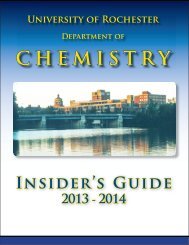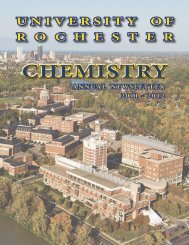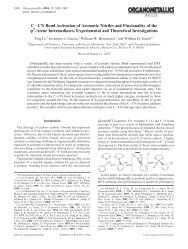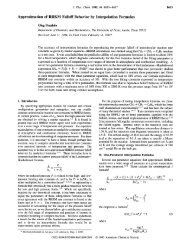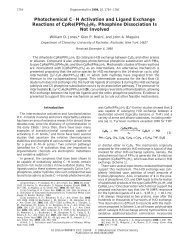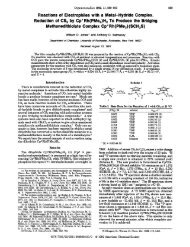Isotope Effects in C-H Bond Activation Reactions by Transition Metals
Isotope Effects in C-H Bond Activation Reactions by Transition Metals
Isotope Effects in C-H Bond Activation Reactions by Transition Metals
Create successful ePaper yourself
Turn your PDF publications into a flip-book with our unique Google optimized e-Paper software.
<strong>Isotope</strong> <strong>Effects</strong> <strong>in</strong> C-H <strong>Bond</strong> <strong>Activation</strong><br />
Jones<br />
(CH 3 ) 2 (D)(CD 3 OD) <strong>in</strong> CD 3 OD solvent, where no claims<br />
about fundamental isotope effects were made. 9f<br />
In another example, Bullock et al. measured an <strong>in</strong>verse<br />
k<strong>in</strong>etic isotope effect for abstraction of hydride ligand from<br />
a CpW(CO) 3 H complex <strong>by</strong> trityl cation. The authors<br />
support a mechanism <strong>in</strong>volv<strong>in</strong>g a direct hydride transfer,<br />
and therefore the <strong>in</strong>verse isotope effect refers to a s<strong>in</strong>gle<br />
reaction step. They did acknowledge, however, that if the<br />
hydride transfer is reversible, then they may be monitor<strong>in</strong>g<br />
an <strong>in</strong>verse equilibrium isotope effect as opposed to a<br />
k<strong>in</strong>etic <strong>in</strong>verse isotope effect. 20 The discussion presented<br />
here would then apply.<br />
F<strong>in</strong>ally, there is one report <strong>in</strong> the literature where an<br />
isotope effect on oxidative cleavage of an alkane has been<br />
directly measured. Moore and Bergman exam<strong>in</strong>ed the<br />
photolysis of Cp*Rh(CO) 2 <strong>in</strong> cyclohexane and cyclohexaned<br />
12 <strong>in</strong> liquid krypton solvent and found that they could<br />
observe <strong>by</strong> IR the conversion of the σ-alkane complex to<br />
the alkyl hydride. The values for k OCH /k OCD were about 10-<br />
15 at 163-193 K. 21 This system is somewhat different from<br />
that described <strong>in</strong> Scheme 3, s<strong>in</strong>ce that alkane is quite labile<br />
and there is a rapid equilibrium between bound krypton<br />
and bound alkane prior to the oxidative cleavage (i.e., the<br />
“right-hand” barrier <strong>in</strong> Scheme 3 would be lower than the<br />
“left-hand” barrier). Similar results were obta<strong>in</strong>ed with<br />
neopentane and neopentane-d 12 . 22<br />
In summary, we have found evidence that the <strong>in</strong>verse<br />
k<strong>in</strong>etic isotope effect for alkane reductive elim<strong>in</strong>ation <strong>in</strong><br />
Tp*Rh(CNR)(alkyl)H compounds is due to an <strong>in</strong>verse<br />
equilibrium isotope effect separat<strong>in</strong>g the alkyl hydride<br />
complex from the σ-alkane complex. This <strong>in</strong>verse equilibrium<br />
isotope effect arises due to two oppos<strong>in</strong>g normal<br />
k<strong>in</strong>etic isotope effects of different magnitudes. The case is<br />
different for arenes <strong>in</strong> Cp*Rh(PMe 3 )(aryl)H compounds,<br />
where the <strong>in</strong>verse equilibrium isotope effect is due to an<br />
<strong>in</strong>verse k<strong>in</strong>etic isotope effect oppos<strong>in</strong>g a small normal<br />
isotope effect. F<strong>in</strong>ally, one is rem<strong>in</strong>ded that statements<br />
regard<strong>in</strong>g isotope effects for a s<strong>in</strong>gle step <strong>in</strong> a more<br />
complex reaction require that more than one isotope<br />
effect measurement be made.<br />
References<br />
(1) For overviews on the subject, see: Jones, W. D.; Kakiuchi, F.;<br />
Murai, S. <strong>Activation</strong> of C-H <strong>Bond</strong>s: Stoichiometric <strong>Reactions</strong> and<br />
Catalytic <strong>Reactions</strong>. In Topics <strong>in</strong> Organometallic Chemistry.<br />
<strong>Activation</strong> of Unreactive <strong>Bond</strong>s and Organic Synthesis; Murai, S.,<br />
Ed.; Spr<strong>in</strong>ger: New York, 1999; Vol. 3, Chapters 2 and 3. Crabtree,<br />
R. H. Aspects of Methane Chemistry. Chem. Rev. 1995, 95, 987-<br />
1007.<br />
(2) Janowicz, A. H.; Bergman, R. G. Carbon-Hydrogen <strong>Activation</strong> <strong>in</strong><br />
Completely Saturated Hydrocarbons: Direct Observation of M +<br />
R-H f M(R)(H). J. Am. Chem. Soc. 1982, 104, 352-354.<br />
(3) Belt, S. T.; Dong, L.; Duckett, S. B.; Jones, W. D.; Partridge, M.<br />
G.; Perutz, R. N. Control of η 2 -Arene Coord<strong>in</strong>ation and Carbon-<br />
Hydrogen <strong>Bond</strong> <strong>Activation</strong> <strong>by</strong> Cyclopentadienyl Complexes of<br />
Rhodium. Chem. Commun. 1991, 266-269. Belt, S. T.; Duckett,<br />
S. B.; Helliwell, M.; Perutz, R. N. <strong>Activation</strong> and η 2 -Co-ord<strong>in</strong>ation<br />
of Arenes: Crystal and Molecular Structure of an (η 2 -Hexafluorobenzene)rhodium<br />
Complex. J. Chem. Soc., Chem. Commun.<br />
1989, 928-930. Re<strong>in</strong>artz, S.; White, P. S.; Brookhart, M.; Templeton,<br />
J. L. Structural Characterization of an Intermediate <strong>in</strong> Arene<br />
C-H <strong>Bond</strong> <strong>Activation</strong> and Measurement of the Barrier to C-H<br />
Oxidative Addition: A Plat<strong>in</strong>um(II) η 2 -Benzene Adduct. J. Am.<br />
Chem. Soc. 2001, 123, 12724-12725.<br />
(4) Hall, C.; Perutz, R. N. <strong>Transition</strong> Metal Alkane Complexes. Chem.<br />
Rev. 1996, 96, 3125-3146.<br />
(5) Brookhart, M.; Green, M. L. H. Carbon- - -Hydrogen-<strong>Transition</strong><br />
Metal <strong>Bond</strong>s. J. Organomet. Chem. 1983, 250, 395-408.<br />
(6) Sweet, J. R.; Graham, W. A. G. A η 2 -Arene Complex of Rhenium:<br />
Synthesis, Characterization, and <strong>Activation</strong> of the Aromatic<br />
Carbon-Hydrogen <strong>Bond</strong>s. Organometallics 1983, 2, 135-140.<br />
Jones, W. D.; Dong, L. Direct Observation of η 2 -Arene Complexes<br />
of [(C 5Me 5)Rh(PMe 3)]. J. Am. Chem. Soc. 1989, 111, 8722-8723.<br />
Harman, W. D.; Taube, H. Reactivity of Pentaamm<strong>in</strong>eosmium(II)<br />
with Benzene. J. Am. Chem. Soc. 1987, 109, 1883-1885. Harman,<br />
W. D.; Sek<strong>in</strong>e, M.; Taube, H. Substituent <strong>Effects</strong> on η 2 -Coord<strong>in</strong>ated<br />
Arene Complexes of Pentaamm<strong>in</strong>eosmium(II). J. Am. Chem. Soc.<br />
1988, 110, 5725-5731. Jones, W. D.; Feher, F. J. Comparative<br />
Reactivities of Hydrocarbon Carbon-Hydrogen <strong>Bond</strong>s with a<br />
<strong>Transition</strong>-Metal Complex. Acc. Chem. Res. 1989, 22, 91-100.<br />
Cordone, R.; Taube, H. Pentaamm<strong>in</strong>eosmium(II) η 2 -2,6-Lutid<strong>in</strong>e:<br />
An Intermediate for Carbon-Hydrogen <strong>Activation</strong>. J. Am. Chem.<br />
Soc. 1987, 109, 8101-8102. Brauer, D. J.; Kruger, C. <strong>Bond</strong><strong>in</strong>g of<br />
Aromatic Hydrocarbons to Nickel(0). Structure of Bis(tricyclohexylphosph<strong>in</strong>e)(1,2-η<br />
2 -anthracene)nickel(0)-toluene. Inorg. Chem.<br />
1977, 16, 884-891. van der Heijden, H.; Orpen, A. G.; Pasman, P.<br />
Photochemistry of Tricarbonyl(η 5 -pentamethylcyclopentadienyl)-<br />
rhenium <strong>in</strong> Benzene Solution; Crystal Structure of bis[dicarbonyl-<br />
(η 5 -pentamethylcyclopentadienyl)](µ-η 2 ,η 2′ -benzene)dirhenium. J.<br />
Chem. Soc., Chem. Commun. 1985, 1576-1578. Neithamer, D.<br />
R.; Parkanyi, L.; Mitchell, J. F.; Wolczanski, P. T. η 2 -(N,C)-Pyrid<strong>in</strong>e<br />
and µ-η 2 (1,2):η 2 (4,5)-benzene Complexes of (silox) 3Ta (silox )<br />
t-Bu 3SiO-). J. Am. Chem. Soc. 1988, 110, 4421-4423. Harman, W.<br />
D.; Taube, H. Synthesis of [Os(NH 3) 5(η 2 -tmb)] 2+ : A Valuable<br />
Precursor for Pentaamm<strong>in</strong>eosmium(II) Chemistry. Inorg. Chem.<br />
1987, 26, 2917-2918. Harman, W. D.; Taube, H. π-Localization <strong>in</strong><br />
Aromatic Ligands: Formation of Mixed-Metal η 2 :η 2 -µ-Arene Complexes<br />
of Ruthenium(II) and Osmium(II) Amm<strong>in</strong>es. J. Am. Chem.<br />
Soc. 1988, 110, 7555-7557. Ch<strong>in</strong>, R. M.; Dong, L.; Duckett, S. B.;<br />
Jones, W. D. Multiple η 2 -Arene Coord<strong>in</strong>ation. Structure and<br />
Isomerism of Naphthalene Complexes of Rhodium Phosph<strong>in</strong>e<br />
[(C 5Me 5)Rh(PMe 3)]. Organometallics 1992, 11, 871-876.<br />
(7) Kiel, W. A.; Ball, R. G.; Graham, W. A. G. Carbonyl-η-Hexamethylbenzene<br />
Complexes of Osmium. Carbon-Hydrogen <strong>Activation</strong><br />
<strong>by</strong> (η-C 6Me 6)Os(CO)(H). J. Organomet. Chem. 1990, 383, 481-<br />
496. Lian, T.; Bromberg, S. E.; Yang, H.; Proulz, G.; Bergman, R.<br />
G.; Harris, C. B. Femtosecond IR Studies of Alkane C-H <strong>Bond</strong><br />
<strong>Activation</strong> <strong>by</strong> Organometallic Compounds: Direct Observation of<br />
Reactive Intermediates <strong>in</strong> Room-Temperature Solutions. J. Am.<br />
Chem. Soc. 1996, 118, 3769-3770. Bromberg, S. E.; Yang, H.;<br />
Asplund, M. C.; Lian, T.; McNamara, B. K.; Kotz, K. T.; Yeston, J.<br />
S.; Wilkens, M.; Frei, H.; Bergman, R. G.; Harris, C. B. The<br />
Mechanism of a C-H <strong>Bond</strong> <strong>Activation</strong> Reaction <strong>in</strong> Room-Temperature<br />
Alkane Solution. Science 1997, 278, 260-263. Sun, X.<br />
Z.; Grills, D. C.; Nikiforov, S. M.; Poliakoff, M.; George, M. W.<br />
Remarkable Stability of (η 5 -C 5H 5)Re(CO) 2L(L) n-heptane, Xe, and<br />
Kr): A Time-Resolved Infrared Spectroscopic Study of (η 5 -C 5H 5)-<br />
Re(CO) 3 <strong>in</strong> Conventional and Supercritical Fluid Solution. J. Am.<br />
Chem. Soc. 1997, 119, 7521-7525.<br />
(8) Reductive elim<strong>in</strong>ation is a term that is used to describe the<br />
cleavage of metal-ligand bonds, the formation of ligand-ligand<br />
bonds, and the dissociation of the coupled product from the metal<br />
center. The metal is formally reduced <strong>by</strong> two electrons <strong>in</strong> the<br />
process. To describe the conversion of the alkyl hydride complex<br />
<strong>in</strong>to the σ-alkane complex without loss of alkane, we will use the<br />
term “reductive coupl<strong>in</strong>g”, with an associated rate constant k RC;<br />
for its microscopic reverse, we will use the term “oxidative<br />
cleavage”, with an associated rate constant k OC, s<strong>in</strong>ce oxidative<br />
addition refers to both coord<strong>in</strong>ation of a substrate and the<br />
cleavage of a bond <strong>in</strong> the substrate.<br />
(9) (a) Buchanan, J. M.; Stryker, J. M.; Bergman, R. G. A K<strong>in</strong>etic and<br />
Thermodynamic Study of the Reversible Thermal Carbon-<br />
Hydrogen <strong>Bond</strong> <strong>Activation</strong>/Reductive Elim<strong>in</strong>ation of Alkanes at<br />
Iridium. J. Am. Chem. Soc. 1986, 108, 1537-1550. (b) Periana, R.<br />
A.; Bergman, R. G. Isomerization of the Hydridoalkylrhodium<br />
Complexes Formed on Oxidative Addition of Rhodium to Alkane<br />
Carbon-Hydrogen <strong>Bond</strong>s. Evidence for the Intermediacy of η 2 -<br />
Alkane Complexes. J. Am. Chem. Soc. 1986, 108, 7332-7346. (c)<br />
Bullock, R. M.; Headford, C. E. L.; Hennessy, K. M.; Kegley, S. E.;<br />
Norton, J. R. Intramolecular Hydrogen Exchange Among the<br />
Coord<strong>in</strong>ated Methane Fragments of Cp 2W(H)CH 3. Evidence for the<br />
Formation of a σ-Complex of Methane Prior to Elim<strong>in</strong>ation. J. Am.<br />
Chem. Soc. 1989, 111, 3897-3908. (d) Park<strong>in</strong>, G.; Bercaw, J. E.<br />
Elim<strong>in</strong>ation Processes for Alkyl, Hydride, and Hydroxy Derivatives<br />
of Permethyltungstenocene. Organometallics 1989, 8, 1172-1179.<br />
(e) Gould, G. L.; He<strong>in</strong>ekey, D. M. Reductive Elim<strong>in</strong>ation of Methane<br />
from a Cationic Rhenium Methyl Hydride. Evidence for an<br />
Intermediate Methane Complex. J. Am. Chem. Soc. 1989, 111,<br />
5502-5504. (f) Stahl, S. S.; Lab<strong>in</strong>ger, J. A.; Bercaw, J. E. J. Am.<br />
Chem. Soc. 1996, 118, 5961-5976. (g) Wang, C.; Ziller, J. W.;<br />
VOL. 36, NO. 2, 2003 / ACCOUNTS OF CHEMICAL RESEARCH 145




